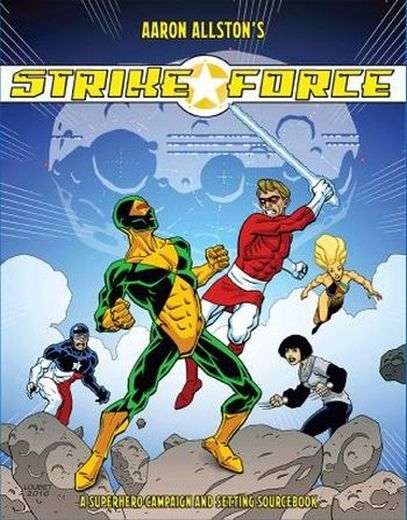In my A Game Per Year project, my goal has been to read one roleplaying game corebook for every year they’ve been published. However, I soon started to feel that it was hard to decipher how the games were really meant to be played. For this reason, I decided to start a parallel project, An Adventure Per Year, to read one roleplaying adventure for each year they’ve been published.

Strike Force was the name of a long running Champions campaign created by the designer Aaron Allston. It was documented in a supplement for Champions Allston wrote in 1988. This book is the second edition of that original release, published after Allston’s untimely death in 2014.
Almost all roleplaying games and adventures are fundamentally normative. They tell you how to do it. I know of a few that have instead attempted a descriptive approach where the goal of the release is to capture a particular existing play culture. Everything is Dolphins and Manhattan 2010 both try to document a specific childhood style of play. I tried to showcase the style of my own community in Chernobyl, Mon Amour and Bad Sex, although both veer into normativity to some degree.
Strike Force is not a campaign book in the sense that it presents a playable campaign. Rather, it’s a description of Allston’s sprawling campaign which lasted for two decades, spawned numerous spin-off campaigns and featured dozens of characters. The new edition is also a memorial to Allston, with numerous testimonies describing his virtues as a designer, friend, GM and human being.
Very long campaigns are my most valued format for roleplay but they’re very hard to document, test and design. How do you playtest something that runs for ten years? These long campaigns become part of the fabric of life for their players and GMs. While many roleplaying games are published so as to make them possible, surprisingly few seriously tackle with the questions raised by such extreme duration.
For example: How to keep things fresh after the five year mark? What about after ten years?
Strike Force makes the attempt, describing how Allston’s campaign evolved and changed. It deals with mundane matters such as scheduling and fundamental design issues such as a genre shift as a method of breathing new life into the game.
Allston’s original Strike Force book is famed for its GM advice and categorization of players by motivation. During this reading project, I’ve come to find almost all GM advice tedious and boring because it repeats common cliches without properly grappling with the core assumptions of each writer’s understanding of what roleplaying is. We’re all prone to thinking our playstyle is normal, when in reality there are an infinite number of variant styles, each adjusted to the preferences and needs of different people. To be able to give advice, you have to understand your own position and idiosyncrasies, which most of us are unable to do.
Against this background, I’ve found it valuable to read and hear about the specific techniques of an individual GM. I’m interested in what worked for Allston, not in what Allston thinks would work for me. Fortunately, the way he writes about being a GM makes his own position visible and understandable. I get a sense of where he comes from and that makes it possible for me to contextualize his description of his methods and choices.
I found Strike Force to be a unique book, wonderful in the way it allowed me to reflect on my own play and GM practice against the example of someone else with a similar focus on extended campaigns.